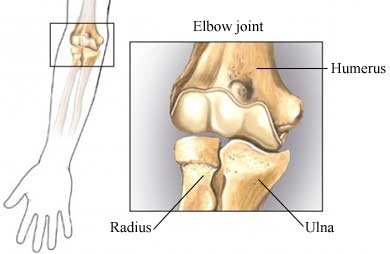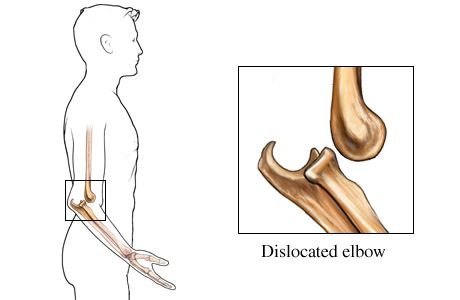Elbow Injuries
ÿ
ÿ
In the past, EVS has dug a little deeper into many of the injuries that motocross riders endure. However, nothing has ever been written on the elbow and its injuries. So this week, the safety crew will take a closer look at the elbow, how it works and what kind of injuries you may expect.
The Elbow’s Connected to the…
The elbow’s main purpose is to serve as a hinge joint that connects the radius and ulna of the forearm to the humerus of the upper arm. The primary ligaments in the elbow, the medial collateral ligament (MCL) and the lateral collateral ligament (LCL), hold the bones together. The elbow consists of three joints enclosed within a shell and is held together by muscles, tendons and ligaments. The muscles surrounding the joints in the elbow are responsible for the movements. In addition, the tendons (strong fibrous cords) attach the muscle to the bone, the cartilage covers and protects the ends of the bones and the bursa sacs (fluid filled cushions) provide lubrication and protection to the joints. The ligaments are bandage-like sheaths of fibrous tissue that keep the joints and bones in alignment.

Common Elbow Injuries
Most physical therapists and physicians deal with two common types of elbow injuries: traumatic and repetitive motion. Traumatic injuries, which include fractures, dislocations, lacerations and amputations, always require immediate medical attention. On the other hand, repetitive motion injuries develop over time and are often the result of computer work or assembly line tasks, not an injury that would occur while riding a dirt bike. While traumatic injuries to the elbow can happen in any sport, especially those that involve throwing or swinging, it’s a very common occurrence among motocross athletes. A fall going around a corner or a harsh landing coming off of that double can easily cause an elbow dislocation or fracture.
Since fractures and dislocations are two of the more common injuries to occur in motocross, let’s take a closer look at them. When a fracture occurs, this means that one of the three bones in the arm (the radius, ulna or humerus) has broken near the elbow joint. A fractured elbow can occur from falling on an outstretched arm or directly hitting the elbow. Fractures may be closed (the broken bone does not break through the skin) or open (the skin is broken over the fracture site and the bone may poke through the skin, or bone may be visible in the wound). In addition, sprains, strains, or dislocations may occur at the same time as a fracture.
Symptoms of a fractured elbow may include:
-
A snap or pop felt or heard at the time of the injury
-
Pain that is likely to increase with arm movement or pressure applied to the area
-
A grating sound or feeling with movement of or pressure on the injured arm
-
An elbow that looks deformed or out of its normal position
-
Changes in feeling, such as numbness or tingling, in the elbow, forearm, or hand
-
Cool, pale, or blue skin on the elbow, forearm, or hand
-
A decreased pulse or no pulse at the wrist
-
Swelling and bruising that appears within 30 minutes of the injury
-
A feeling of looseness or instability at the elbow
-
Decreased ability or inability to move the arm (not because of pain)
-
A bone poking through the skin or visible in a wound
It’s important to remember that a mobile joint does not always mean a fracture is not present. In the event of a crash out on the track where you may have fractured your elbow, it’s very important to shield your injured arm and get off the track as quickly as possible. If you think you have fractured your elbow, the first thing to do is immobilize it and then be examined by a physician as soon as possible.
A dislocated elbow simply means that the elbow joint has popped out of its normal position.

A dislocated elbow can cause:
-
Severe pain
-
Swelling and bruising
-
A feeling that a bone popped or moved out of place
-
A loose or unstable joint
-
Abnormal movement of a limb or joint
-
A locked joint (can’t bend or straighten it)
-
Cool, pale skin with numbness and tingling at the injury site
A dislocated bone may also damage blood vessels, nerves, ligaments, tendons and muscles that are close to the bone.
Treatment and Therapy
Physical therapists and physicians regularly see patients who have suffered traumatic injuries in addition to less severe injuries such as sprains. In the more serious cases, the physical therapist and physician will work together in order to plan a course of therapy action for the patient after his or her condition has stabilized.
Most elbow injuries will include initial first aid treatment, use of a brace, splint or cast, physical therapy, medication and in some cases, surgery. Many of the treatment procedures depend on such things as:
-
Location, type and severity of the injury
-
How long ago the injury occurred
-
Your age, health condition, and activities, such as work, sports, or hobbies
What Matters Most
While you’re ripping it up on the track, most injuries occur very fast and you often have no time to prevent any of them. However, you should be wearing all of the necessary protection equipment, including some type of elbow pad because you never know when you’ll be needing it! So strap one on, hit the track and have fun!
“EVS ? Winning with Safety”





Comments are closed.